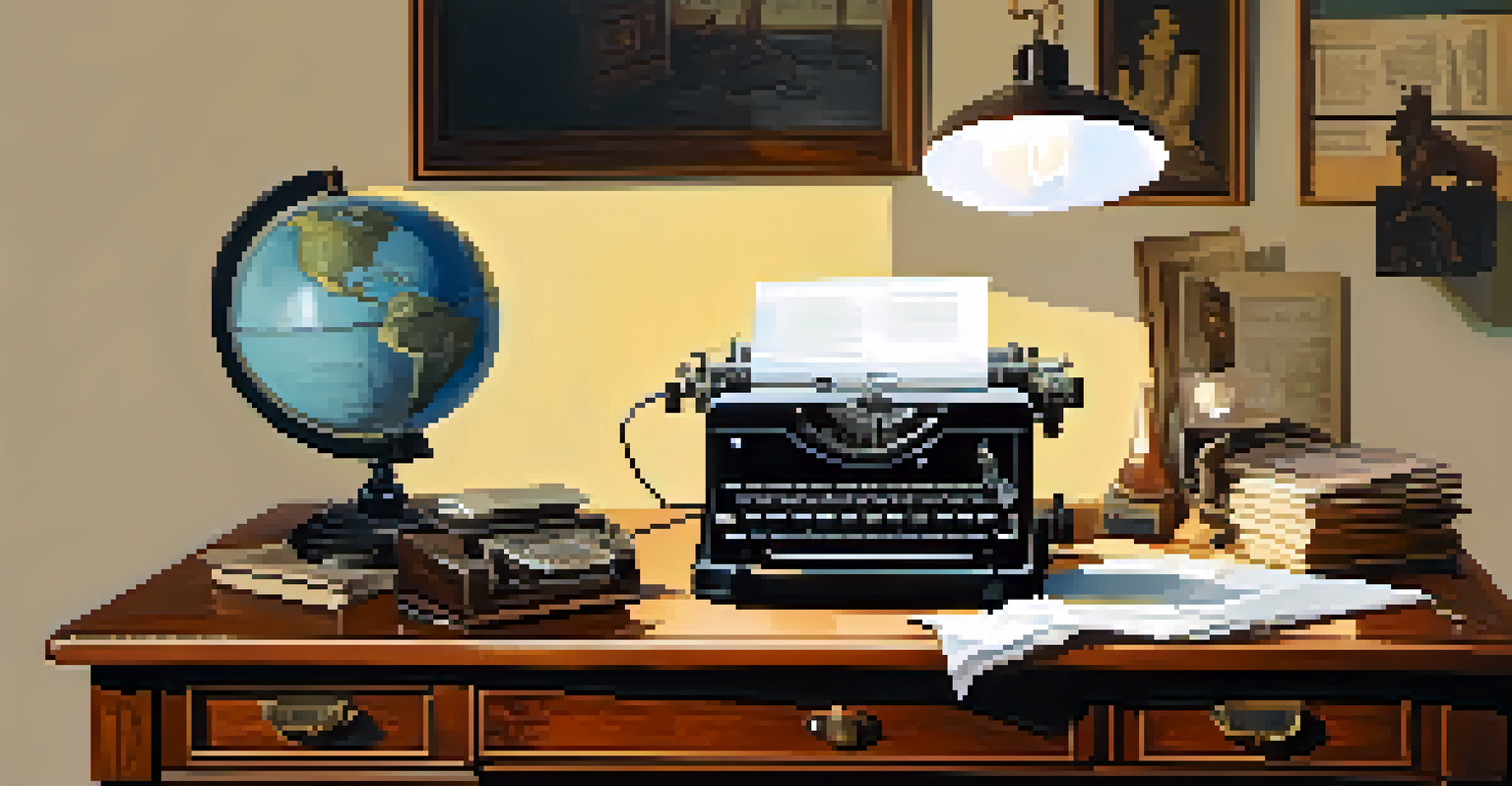Creating Atmosphere: The Role of Props in World-Building

Understanding World-Building and Its Importance
World-building is the art of creating a fictional universe that feels real and immersive. It encompasses everything from the geography to the cultures within that world. An effective world can transport audiences, making them feel like they are part of the story rather than mere observers.
The best stories are the ones that are born from the world around us, and the props we choose can help bring that world to life.
Props play a crucial role in this process, as they add layers of depth and detail that bring the world to life. Think about your favorite movies or books—what did the settings look like? Often, it’s the little things, like a weathered map or a unique artifact, that create a sense of authenticity.
By using props strategically, creators can evoke emotions, hint at backstories, and provide visual cues that enhance the narrative. Just as a painter uses colors to convey feelings, storytellers use props to build atmosphere.
The Power of Props in Storytelling
Props are more than just decorations; they are integral to storytelling. They can symbolize themes or character traits, making them a powerful tool for writers and filmmakers. For instance, a broken clock on a wall might signify a character's halted emotional state.

Moreover, props can serve as plot devices. A seemingly innocuous item, like a letter or an old photograph, can trigger significant events in the story. This adds an additional layer of intrigue and keeps the audience engaged, constantly wondering how these objects will play a role.
World-Building Enhances Immersion
Effective world-building creates a rich, immersive experience that transports audiences into the story.
Ultimately, props enhance the storytelling experience by providing tangible connections to the narrative, allowing audiences to relate to characters and their journeys on a deeper level.
Creating Atmosphere with Props
Atmosphere is the emotional setting of a scene, and props are essential in crafting it. The choice of props can evoke specific feelings—think of a cozy fireplace or a dark, foreboding castle. Both create vastly different moods, influencing how an audience feels.
Every great story begins with a great world; props are the embodiment of that world, giving it texture and meaning.
For example, in a romantic scene, soft lighting and delicate flowers can create a sense of intimacy. Conversely, in a horror story, unsettling objects like a doll with a cracked face can heighten tension and fear. The right props can transform a simple setting into something memorable.
By carefully selecting props that align with the desired atmosphere, creators can guide the audience’s emotional responses, making the experience more immersive and impactful.
Symbolism and Meaning Behind Props
Props often carry deeper meanings, serving as symbols that enhance the story. A sword, for example, might represent honor and courage, while a mirror could symbolize self-reflection or vanity. These layers of meaning enrich the narrative and invite audiences to think critically about the story.
When creators use props symbolically, they can subtly convey messages without overt exposition. This allows audiences to engage with the story on multiple levels, finding personal interpretations that resonate with them.
Props Serve as Storytelling Tools
Props are integral to storytelling, symbolizing themes and enhancing character development while keeping audiences engaged.
Ultimately, the symbolism behind props can elevate a story, making it not only entertaining but also thought-provoking. It connects the audience with the characters' journeys and dilemmas.
Practical Tips for Using Props in Your Work
When incorporating props into your storytelling, start with the narrative’s core themes. Consider what objects would naturally exist within your world and how they could support character development or plot progression. It's essential that each prop has a purpose.
Additionally, don’t shy away from using everyday items. Sometimes, the most relatable props resonate with audiences the most. A simple cup of coffee can convey comfort, while a tattered book might evoke nostalgia.
Lastly, always keep your audience in mind. Think about how different props might be perceived and how they can enhance the overall experience, ensuring that they contribute to the story rather than distract from it.
The Role of Props in Different Mediums
Props play varying roles across different storytelling mediums—be it film, theater, or literature. In film, props can be visually striking and immediately impactful, enhancing the overall aesthetic. They can also be manipulated for dramatic effect, such as a character wielding a weapon during a climactic scene.
In theater, props are often more limited due to space and budget constraints, which makes their role even more crucial. Each item must convey meaning quickly, as the audience has only a short time to grasp its significance. The use of props becomes an art form in itself.
Atmosphere Influenced by Props
Carefully selected props craft the emotional atmosphere of a scene, guiding audience reactions and enhancing the narrative.
Literature, while lacking physical props, can still evoke imagery through descriptive language. Writers can craft vivid scenes that allow readers to picture the props in their minds, creating a unique atmosphere through words alone.
Case Studies: Effective Use of Props in Popular Media
Examining successful examples can shed light on how props effectively contribute to storytelling. In 'Harry Potter', the use of wands is not just about magic; they symbolize each character's identity and growth. The way they interact with their wands adds depth to their character arcs.
Another example is in 'The Great Gatsby', where the green light serves as a powerful symbol of hope and aspiration for Gatsby. It’s woven into the narrative, constantly reminding both the character and the audience of his dreams.

These case studies illustrate how props can transform narratives, providing insight and emotional resonance that enrich the overall story.